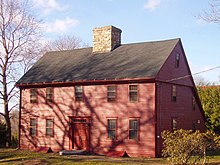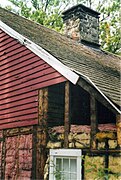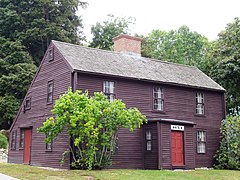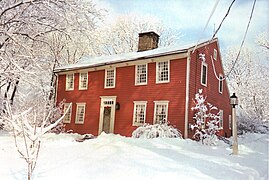Saltbox house
A saltbox house is a gable roofed residential structure that is typically two stories in the front and one in the rear. It is a traditional New England style of home, originally timber framed, which takes its name from its resemblance to a wooden lidded box in which salt was once kept.
The structure’s unequal sides and long, low rear roof line are its most distinctive features. A flat front and central chimney are also recognizable traits.
Origins[]

The saltbox originated in New England and is an example of American colonial architecture. Its shape evolved organically as an economical way to enlarge a house by adding a shed to a home’s rear.
The roof style is also known as a catslide roof – any roof that, in part, in the same plane, extends down below the main eave height, providing greater area under the roof.[1]
Original hand-riven oak clapboards are still in place on some the earliest New England saltboxes, such as the Comfort Starr House and Ephraim Hawley House. Once part of their exteriors, they are preserved in place in attics that were created when shed-roofed additions were added onto the homes.
The style was popular for structures throughout the colonial period and into the early Republic for its ability to enlarge the footprint of an existing structure at a minimum of cost.
Saltbox homes can also be found in parts of Newfoundland and Labrador.[citation needed]
Construction[]
Characteristic of most early New England colonial houses, saltboxes were timber-framed. Also known as post-and-beam construction, the technique joins large pieces of wood with mortise-and-tenon joints, wooden pegs, braces, or trusses. Metal nails were sparingly used, as they were an expensive commodity at the time. The exterior of a saltbox was often finished with clapboard or other wooden siding. The Josiah Day House in West Springfield, Massachusetts, is constructed of brick.[2]
Images[]

Ephraim Hawley House, Nichols, Connecticut, catslide rear roof
Ephraim Hawley House, Nichols, Connecticut; original oak clapboards in lean-to attic

Multiple-pitched catslide roof Thomas Hawley House
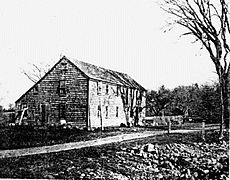
c. 1643 Edmund Rice homestead in Sudbury (now Wayland, Massachusetts), destroyed by fire c. 1912
c. 1651 Macy–Colby House, Amesbury, Massachusetts
c. 1683 Ephraim Hawley House, Nichols, Connecticut
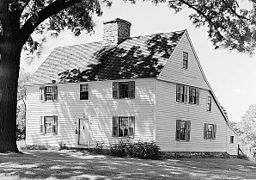
c. 1695 Comfort Starr House, Guilford, Connecticut
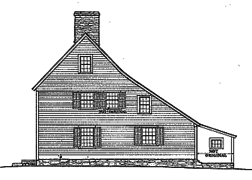
Side elevation of c. 1695 Comfort Starr House illustrating the multiple-pitched roof line
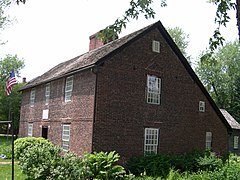
c. 1754 Brick Josiah Day House West Springfield, Massachusetts
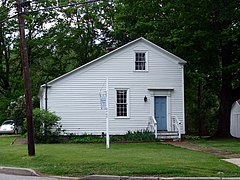
c. 1838, Sturgeon House, Fairview, Pennsylvania
See also[]
References[]
- ^ "Roof options for your oak-framed building". ehbp.com. English Heritage Buildings. Retrieved 19 October 2017.
- ^ "Joshua Day House Museum". west-springfield.ma.us. West Springfield, Massachusetts. Archived from the original on 2010-03-09. Retrieved 2009-07-19.
External links[]
- Saltbox architecture
- American architectural styles
- House styles
- 18th-century architecture
- 19th-century architecture
- Housing in the United States
- Vernacular architecture

